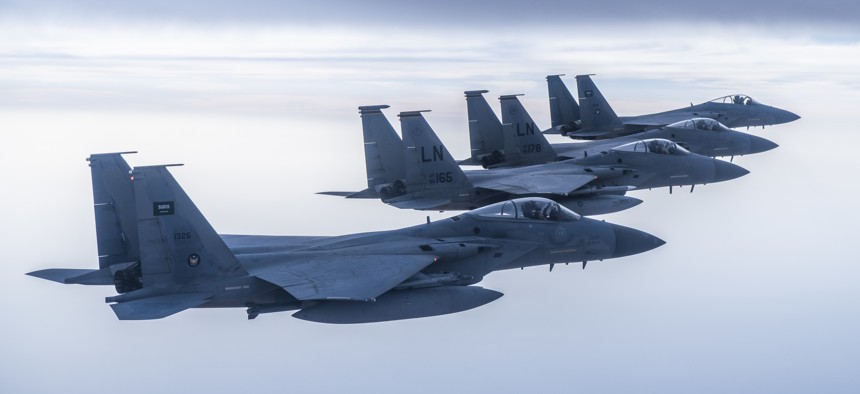
U.S.-made Royal Saudi Air Force F-15C Eagles fly in formation with U.S. Air Force F-15Cs in the U.S. Central Command area of responsibility, June 2, 2019. Royal Saudi Air Force via USAF
Some Arms Exports Are Riskier Than Others. Here’s a Tool To Tell Which Ones
The problems with selling weapons to Saudi Arabia and Turkey were hardly unpredictable.
The role of arms sales in American foreign policy is often framed as a win-win-win scenario. Administration officials appreciate the flexibility that arms sales provide for diplomacy; they tout weapons deliveries as a way to maintain alliances and create leverage with recipient nations. Allies, in turn, get access to the most technologically advanced weapons without having to create defense industries that compete (too much) with American firms. And the bottom line means that more money flows into American companies that employ skilled American workers. Win. Win. Win.
But history reveals several flaws in this logic. For example, the United States does not only sell weapons to allies, an issue that members of Congress have grappled with intensely this year. From 2002 to 2018, the United States sold weapons to our 29 NATO allies and 46 non-NATO allies, but also to 110 other countries with which we do not have security agreements. In fact, over the past 17 years, the United States sold more weapons — as measured by total dollar value — to non-allies than to NATO allies.
Related: Pentagon’s Focus On China and Russia Expected to Alter US Arms Sales
Related: The False Promises of Trump’s Arms Sales
Related: 70 Percent of Americans Say Arms Sales Make US Less Safe
Many of these customers have been authoritarian regimes that have horrendous human rights records or are engaged in destructive conflicts fueled by arms imports. Since 2002, the United States has sold weapons to 81 percent of the countries in the world rated as “not free” by Freedom House, 86 percent of the nations engaged in conflict, and to six of the nine countries ranked in the worst category for political violence by the State Department.
To help policy makers assess the potential risks from arms sales, we have devised the Arms Sales Risk Index. The index assesses factors like political freedom, corruption, and human rights records that correlate with negative downstream consequences from arms sales. The index reveals, for example, that among the 15 riskiest customers of U.S. arms manufacturers are Nigeria, Thailand, Colombia, Kenya, Egypt, and the Philippines, all of whose track records should induce serious levels of foreign policy caution.
The second issue, in contrast to the rhetoric from Washington, is that arms sales seem to have little bearing on the leverage U.S. policymakers can exert on other sovereign countries. Both Congress and the Trump administration have recently rediscovered how tenuous the notion of leverage can be as the United States has tried without much luck to influence Saudi Arabia’s behavior in Yemen and elsewhere.
In the wake of efforts to block arms sales to Saudi Arabia that were ultimately scuttled by a presidential veto, a bipartisan group of senators introduced the Enhancing Human Rights in Arms Sales Act. Legislation designed to ensure that “U.S. manufactured weapons are not used in the commission of heinous war crimes, the repression of human rights, or by terrorists who seek to do harm to Americans and innocent civilians abroad.” But despite these efforts, Saudi Arabia continues its deadly campaign in Yemen with no signs of reform or interest in diplomatic negotiations.
Nor is selling weapons to allies always a straightforward business. Turkey, for example, is a NATO ally, host of U.S. troops and nuclear weapons, and — until recently — a key partner in the F-35 program. Turkey contributes to the program’s chain of production—close to a thousand parts for the jets are produced or assembled in Turkish facilities. Turkey also placed an initial order of 100 F-35s, in line with typical American arms sales strategy of providing allies with top-tier technology.
Unfortunately for Washington, Turkey also recently decided to purchase the Russian-made S-400 air defense system. The S-400 is designed to shoot down incoming threats, including fighter jets like the F-35. American policymakers worry that basing this kind of Russian technology alongside U.S. systems creates intelligence risks and could make the F-35 more vulnerable. Neither Washington’s swift condemnation, nor threats to cut Turkey out of the F-35 project have created sufficient leverage to halt Turkey’s purchase of the S-400.
Sadly, neither the problems with Saudi Arabia or Turkey were unpredictable. Both nations score high on the Arms Sales Risk Index. In fact, they ranked seventh and eighth respectively among the riskiest customers to have purchased more than $100 million in weapons since 2002.
Despite the obvious risks involved with the arms trade, however, Trump seems no more inclined that past presidents to worry much about the potential consequences. In fact, Trump has championed arms sales not only as a tool of foreign policy but (erroneously) as a major boon for the American economy, reshaping federal policy to encourage a whole-of-government approach to arms sales. It is no surprise that arms sales under Trump have been rising. Nor, unfortunately, will it be much of a surprise years from now when many of those American weapons wind up lost, stolen, or misused with tragic consequences.



